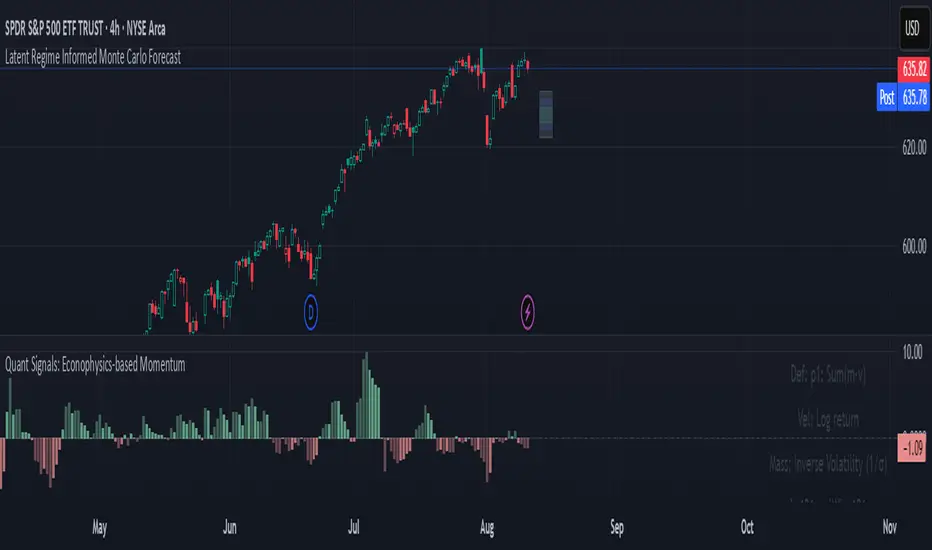OPEN-SOURCE SCRIPT
Güncellendi Quant Signals: Econophysics-based Momentum

Physical Momentum Switcher (p0 / p1 / p2 / p3)
This indicator implements a “physical momentum” concept from quantitative finance research, where momentum is defined similarly to physics:
Momentum (p) = Mass × Velocity
Instead of using only the standard cumulative return (classic momentum), it lets you switch between multiple definitions:
Velocity can be measured as:
Mass (for p1/p2) can be defined as:
Features:
Typical uses:
Momentum trading: Buy when PM > 0 (or crosses above the signal), sell/short when PM < 0 (or crosses below).
Contrarian strategies: Reverse the logic when testing mean-reversion effects.
Cross-asset testing: Apply to different instruments to see which PM definition works best.
This indicator implements a “physical momentum” concept from quantitative finance research, where momentum is defined similarly to physics:
Momentum (p) = Mass × Velocity
Instead of using only the standard cumulative return (classic momentum), it lets you switch between multiple definitions:
- p0: Cumulative return over the lookback period (no mass, just price change).
- p1: Sum of (mass × velocity) over the lookback period.
- p2: Weighted average velocity = (Σ mass×velocity) ÷ (Σ mass).
- p3: Sharpe-like momentum = average velocity ÷ volatility (massless).
Velocity can be measured as:
- Log return: ln(Pt / Pt-1)
- Normal return: (Pt / Pt-1 – 1)
Mass (for p1/p2) can be defined as:
- Unit mass (1) — equal weighting, equivalent to traditional momentum.
- Turnover proxy — Volume ÷ average volume over k bars.
- Value turnover proxy — Dollar volume ÷ average dollar volume.
- Inverse volatility — 1 ÷ return volatility over a specified period.
Features:
- Switchable momentum definition, velocity type, and mass type.
- Adjustable lookback (k) and smoothing period for the signal line.
- Optional ±1σ display bands for quick overbought/oversold visual cues.
- Alerts for crosses above/below zero or the signal line.
- Table display summarizing current settings and values.
Typical uses:
Momentum trading: Buy when PM > 0 (or crosses above the signal), sell/short when PM < 0 (or crosses below).
Contrarian strategies: Reverse the logic when testing mean-reversion effects.
Cross-asset testing: Apply to different instruments to see which PM definition works best.
Sürüm Notları
Added histogram viewAçık kaynak kodlu komut dosyası
Gerçek TradingView ruhuyla, bu komut dosyasının mimarı, yatırımcıların işlevselliğini inceleyip doğrulayabilmesi için onu açık kaynaklı hale getirdi. Yazarı tebrik ederiz! Ücretsiz olarak kullanabilseniz de, kodu yeniden yayınlamanın Topluluk Kurallarımıza tabi olduğunu unutmayın.
Feragatname
Bilgiler ve yayınlar, TradingView tarafından sağlanan veya onaylanan finansal, yatırım, alım satım veya diğer türden tavsiye veya öneriler anlamına gelmez ve teşkil etmez. Kullanım Koşulları bölümünde daha fazlasını okuyun.
Açık kaynak kodlu komut dosyası
Gerçek TradingView ruhuyla, bu komut dosyasının mimarı, yatırımcıların işlevselliğini inceleyip doğrulayabilmesi için onu açık kaynaklı hale getirdi. Yazarı tebrik ederiz! Ücretsiz olarak kullanabilseniz de, kodu yeniden yayınlamanın Topluluk Kurallarımıza tabi olduğunu unutmayın.
Feragatname
Bilgiler ve yayınlar, TradingView tarafından sağlanan veya onaylanan finansal, yatırım, alım satım veya diğer türden tavsiye veya öneriler anlamına gelmez ve teşkil etmez. Kullanım Koşulları bölümünde daha fazlasını okuyun.